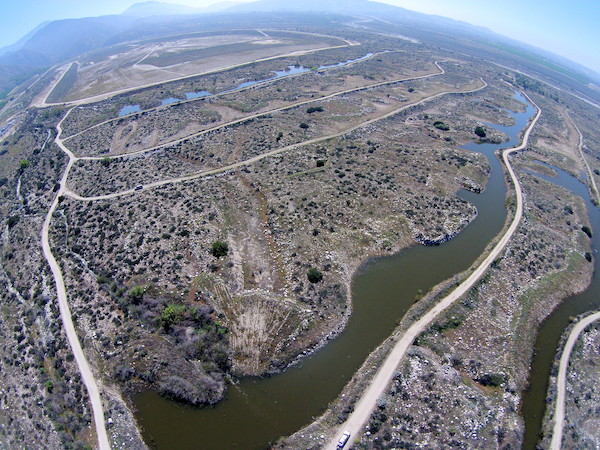
A successful 90-year history, including the completion of several collaborative projects, have made the most of local water recharge capabilities, with more work planned for enhanced storage in the future.
REDLANDS, Calif. (Feb. 25, 2022) — The past 22 years in the West have been dryer than any period in the last 1,200 years. And while human impact on the environment through climate change has made the situation worse – local collaboration has helped to lessen these impacts with innovative water storage techniques that benefit both nature and community.
Recent projects to enhance the capture and percolation of water into the basin have dramatically improved the region’s ability to weather the drought – a fact of growing importance given severe restrictions on State Water Project water to the area, and local precipitation levels at just 56% of normal so far this year. These projects include:
- 2018: The formation of the San Bernardino Basin Groundwater Council, which encourages collaboration among agencies to manage water levels within the local basin.
- 2019: Completion of Phase 1 of an Enhanced Recharge Project, designed and built by San Bernardino Valley Municipal Water District to capture and recharge storm water under the eventual ownership and management of the Conservation District.
- 2020: Approval of the Upper Santa Ana River Wash Habitat Conservation Plan, which manages land uses within the wash to protect groundwater replenishment, native habitat for threatened species, along with industry and recreational uses for the community.
- 2020-2022: Establishment of the Plunge Creek Conservation Project, which restored the creek back to a naturally braided stream to significantly improve groundwater storage while increasing habitat for the endangered San Bernardino Kangaroo Rat and other sensitive species. By January 2022, the project created 11.7 acres of new wetted area to recharge the aquifer, including 2.3 acres of constructed channels and 9.4 acres of new recharge areas formed from flows.
Moving forward, the District will continue to enhance the capacity for water storage in the valley. Most recently, it has been partnering with the San Bernardino Valley Municipal Water District to implement several new projects, continuing the work of the Groundwater Council, and implementing plans to leverage existing infrastructure to serve as the next generation of multiple benefit facilities to help the region make the most of its local water sources. Three engineering studies are underway to evaluate the practical, environmental, and financial feasibility of using flood management facilities for both water recharge and improved protection of life and property.
“One of our biggest strengths has been our ability to make the most of local conditions to enhance groundwater storage for the region,” said General Manager Daniel Cozad. “We believe in working with others, and are astonishingly frugal – finding practical, low-cost solutions that work for the long haul. True to our motto, we help nature store our water, and that approach benefits everyone.”
A brief history of water management in the valley:
- 1770s: Spanish arrive in the valley and Franciscan missionaries establish the Rancho San Bernardino in Redlands, commonly known as the Asistencia, which served as an outpost for the Mission San Gabriel. To support agriculture, local members of the Maara’yam community were forced to build the Mill Creek Zanja – a 12-mile irrigation canal from Mentone into Loma Linda.
- 1850s: The damming of streams sparked skirmishes that prompted feuds and legal battles throughout the region.
- 1909: Leaders from San Bernardino, Riverside and Orange Counties created the Water Conservation Association with the shared goal of spreading floodwater from the Santa Ana River and storing it underground to replenish the aquifer while still providing a reliable source of flow downstream.
- 1930s: Over time, water levels in the San Bernardino Valley basin dipped precariously low due to drought, water waste, and increased exportation. In 1932, the San Bernardino County Board of Supervisors established the San Bernardino Valley Water Conservation District to focus efforts on optimizing groundwater replenishment for future use.
- 1960s: This period brought more lawsuits, including one filed by three Inland Empire women – Ruth Wilson, Martha McLean and Kay Black – who went up against the Army Corps of Engineers and prevailed in blocking plans to pave over the Santa Ana River with concrete, like the Los Angeles River. Today, because of their efforts, the Santa Ana River runs along a soft-bottomed channel that supports nature and allows water to sink into the aquifer.
- 2000s: The new millennia sparked a dramatic spirit of collaboration among local water districts and other agencies. Much of that was the result of San Bernardino Valley Water Conservation District’s early work to establish cooperative projects such as the Groundwater Council and Wash Plan.
About the San Bernardino Valley Water Conservation District:
For nearly a century, the SBVWCD has stewarded the San Bernardino Valley water basin and the native species of the Upper Santa Ana River Wash. Its collaborative approach to project management assures high-quality local water supplies for people, agriculture, and the environment. This includes groundwater recharge and oversight, and protection of habitat and native species in the Wash. Visit www.sbvwcd.org.
